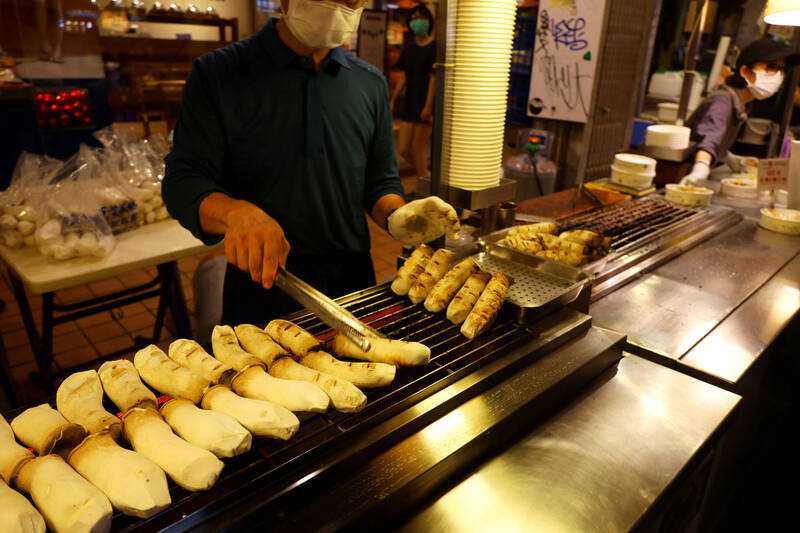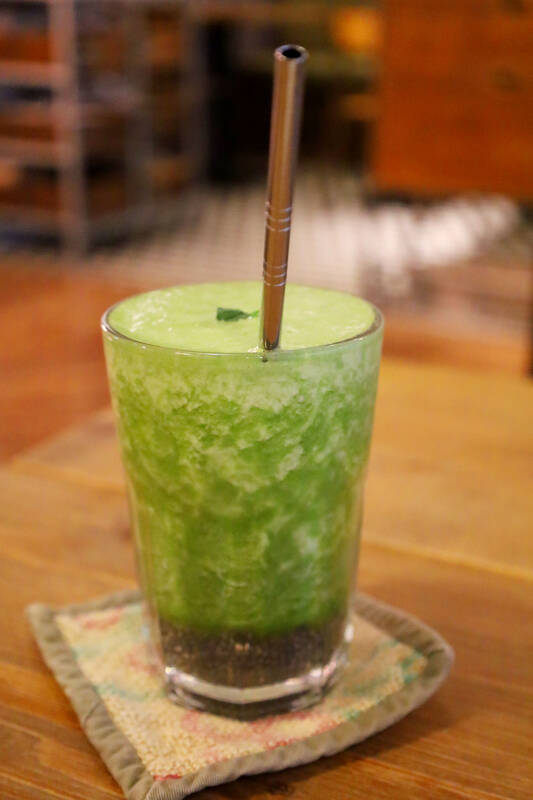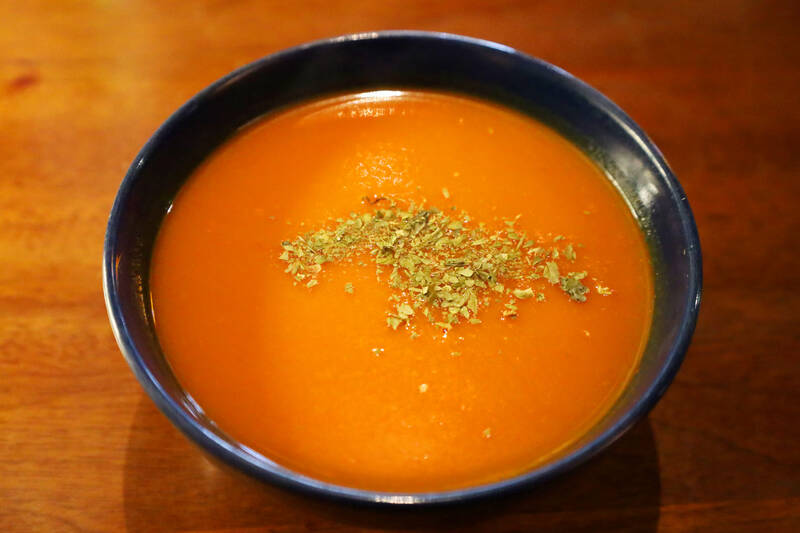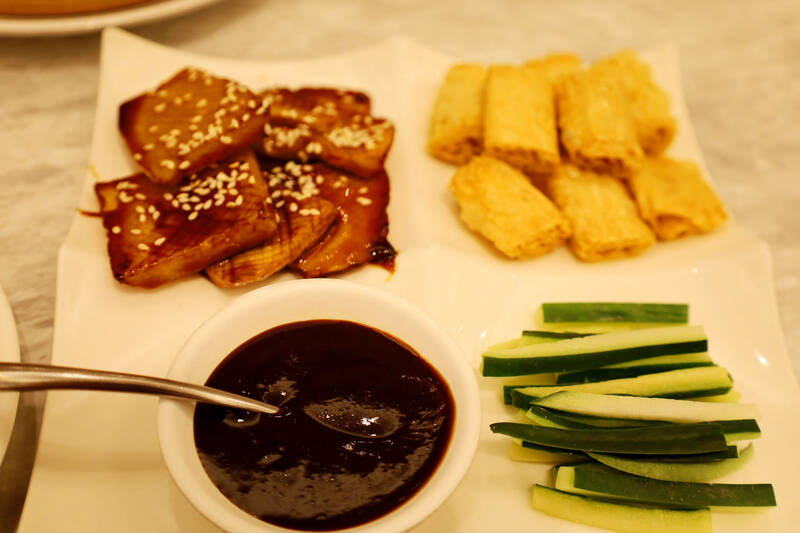The seeds of a modern vegetarian lifestyle were sown amid the transformative counterculture movement of the 1970s. Fifty-years on, the consensus that a meat-free diet is not just ethical and healthy but better for the planet (meat production accounts for between 15 and 20 percent of global emissions) has normalized pant-based living across much of North America, Europe and beyond.
This culinary wave has carried with it new terminology, ovo-vegetarian, lacto-ovo vegetarian, vegan and flexitarian. Wherever you find yourself on the foodie spectrum, Taiwan can seem like a pretty daunting place. Celebrated dishes like beef noodles (牛肉麵), Taiwanese-style fried chicken (鹹酥雞) and braised pork rice (滷肉飯) don’t exactly wave the green flag at newcomers.
Internationally too, the menu can appear limited. The Japanese period (1895-1945) has left a strong cultural imprint, evidenced in sushi bars on every second street, while American food made serious inroads in the post-war USAID-era introducing wheat and processed meats like hot dogs to the Formosan diet.

Photo: Thomas Bird, Taipei Times
A BRIEF HISTORY OF TAIWANESE VEGETARIANISM
In reality, vegetarian diets were commonplace in East Asia a thousand years before Linda McCartney managed to make a mass-market sausage out of some soybeans.
It was during the Song Dynasty (960-1279) that chefs first began making delectable meat alternatives out of mushrooms, beans and root vegetables. The vegetarian eating culture had its roots in religion, the Mahayana Dharmic concept of ahimsa (nonviolence), an “Eastern philosophy” that would inspire Californians to invent “hippie food” centuries later.

Photo: Thomas Bird, Taipei Times
Some Chinese became vegetarian in order to improve their karma; others became flexitarians in order to observe important dates like the 1st and 15th days of the lunar calendar, Lunar New Year’s eve and ancestral holy days. Others still would practice vegetarianism to pay penance or while mourning a loved one after a bereavement. Zen monks would make veganism integral to their religious practice.
Over subsequent centuries, Han migration to Taiwan brought with it Buddhist traditions, manifest in the temples that festoon the island as well as colorful pageantry that accompanies auspicious dates of the Buddhist calendar.
After the Chinese civil war ended in 1949, Buddhism fell under the boot of communism across the strait. In Taiwan, the faith survived political turmoil to flourish. Buddhism’s popularity has, indeed, risen in concert with economic and social progress — a phenomenon that has been dubbed “democracy’s dharma.”

Photo: Thomas Bird, Taipei Times
Today, the government estimates that 13 percent of Taiwan’s population is now vegetarian, around three million people, making Formosa the second highest per capita population of human herbivores anywhere in the world.
NAVIGATING THE VEGGIE-SCAPE
There are more vegetarian restaurants in Taiwan than you could possibly hope to visit unless you plan on eating out for the next four and a half years (the Happy Cow Web site currently lists 472 veggie-friendly establishments in Taipei, and 1,656 nationwide).

Photo: Thomas Bird, Taipei Times
Taiwanese vegetarian restaurants are not just numerous but diverse and can take the form of a meatless steamed-bun stall or a hipster health food store in a trendy mall.
The food can be equally eclectic, as Taiwan Tourism’s Web site poetically puts it: “Taiwan’s tropical-to-temperate climate profile and undulating topography support a diverse agriculture. The country’s many small farms shorten farm-to-table distances, encouraging chefs to create menus that capture the true character and taste of their regions.”
Simply put, diners can anticipate regional delicacies, from bitter gourd to water bamboo to lotus seeds, dished-up in even the humblest of eateries. Conversely, you’re unlikely to encounter strong flavors due to the traditional avoidance of the five pungent roots (五辛), which include onions, chives, garlic, green onions and leeks. Alcohol might also be exempt from the menu in some Buddhist restaurants, although Western-style vegan restaurants don’t to tend to abide by religious dogma.
The most commonplace meat-free eatery in Taiwan are the vegetarian buffet restaurants like Vegetable Foods (陽光健康素食) in Neihu District (內湖). These kind of restaurants lay out a buffet-style spread of tofu and vegetable dishes. Simply grab some tongs, fill up your takeaway box or cover your plate then pay by the weight (the price shouldn’t exceed NT$130). You might be asked if you want to add rice (white rice, five grain rice or purple rice) and broth is often complimentary. Remember, it pays to dine early, before the best dishes are devoured and the food turns cold.
Another good money-saving option is to frequent one of Taiwan’s celebrated night markets. While these bustling boroughs might be scented with aroma of sizzling squid, there’s plenty to satisfy a hungry herbivore. In Shihlin Night Market (士林夜市), Taipei’s largest, a long line forms each night outside Barbecued King Oyster Mushrooms (燒烤杏鮑菇) with customers eager to snack on nutritional fungi marinated in a choice of flavors. The market also has barbequed corn stalls and cold noodle vendors that advertise vegetarian-options on request.
Classic Dim Sum needn’t be a meaty affair. Yang Shin Vegetarian Restaurant (養心茶樓蔬食飲茶) located on the second floor above a bakery in Zhongshan District (中山) is said to be Taipei’s first, as well as its most authentic, vegetarian dim sum restaurant. Hand-rolled deep-fried pumpkin (NT$85), Shanghai soup dumpling made with vegan pork (NT$108) and Peking-style duck made with mushrooms (NT$330) are just some of sumptuous classics on the menu. The restaurant is also promoting its own range of veggie “fortune” zongzi (sticky rice dumplings) ahead of Dragon Boat Festival, which will be held on June 10. Just be aware that dim sum is best consumed in the company of friends.
The cool crowd heads to Plants, which offers customers a plant-based dining experience that is more in tune with restaurants in the West. The place has the airy vibe of a hip coffee shop and hums to an alt-rock soundtrack. In addition to energy bowls (NT$220-360), fruit smoothies (NT$200-250) and the best lentil falafel plate (NT$390) east of Cairo, this “wholesome eatery” also vends vegan cookbooks, organic milk and cheese alternatives, even alcohol-free wine “for those who are driving” apparently.
Located on the second floor of the downtown department store Shin Kong Mitsukoshi Xinyi Place A4 (新光三越 台北信義新天地A4) you’ll find the swankiest restaurant on our list. Herbivore (Herbivore A4信義店 Vegan料理) is where the white-collar crowd gather to talk shop over beans and greens. Tellingly, you can expect to pay between NT$400–NT$600 per person, although the dining experience is very much worth it. There’s an open kitchen where you can watch chefs work their vegan magic, a digital menu from where customers order fine wines (NT$240 per glass) and signature dishes like roasted cauliflower with vegan creme fraiche dip and vegan donuts (NT$395) via a smartphone. Additionally, there’s a solid range of coffees, teas and vegan pastries, should you be looking to entertain someone between meal times.
Fusion veggie dining is best experienced at Red Room Rendezvous (紅房餐酒館), a vegan restaurant at the heart of Daan District (大安) that blends “Western, Taiwanese and Mediterranean” plant-based cooking. Dishes like the vegan voodoo platter (NT$380) and the kimchi rainbow roll (NT$200) are really inventive, while soups and veggie burgers have a good old homecooked flavor. Red Room Rendezvous also houses a gallery, event space and bar, with some choice craft beers on tap and bar stools where solo diners can perch themselves, making it a more casual affair than other upscale vegan eateries.

This month the government ordered a one-year block of Xiaohongshu (小紅書) or Rednote, a Chinese social media platform with more than 3 million users in Taiwan. The government pointed to widespread fraud activity on the platform, along with cybersecurity failures. Officials said that they had reached out to the company and asked it to change. However, they received no response. The pro-China parties, the Chinese Nationalist Party (KMT) and Taiwan People’s Party (TPP), immediately swung into action, denouncing the ban as an attack on free speech. This “free speech” claim was then echoed by the People’s Republic of China (PRC),

Exceptions to the rule are sometimes revealing. For a brief few years, there was an emerging ideological split between the Democratic Progressive Party (DPP) and Chinese Nationalist Party (KMT) that appeared to be pushing the DPP in a direction that would be considered more liberal, and the KMT more conservative. In the previous column, “The KMT-DPP’s bureaucrat-led developmental state” (Dec. 11, page 12), we examined how Taiwan’s democratic system developed, and how both the two main parties largely accepted a similar consensus on how Taiwan should be run domestically and did not split along the left-right lines more familiar in

As I finally slid into the warm embrace of the hot, clifftop pool, it was a serene moment of reflection. The sound of the river reflected off the cave walls, the white of our camping lights reflected off the dark, shimmering surface of the water, and I reflected on how fortunate I was to be here. After all, the beautiful walk through narrow canyons that had brought us here had been inaccessible for five years — and will be again soon. The day had started at the Huisun Forest Area (惠蓀林場), at the end of Nantou County Route 80, north and east

Specialty sandwiches loaded with the contents of an entire charcuterie board, overflowing with sauces, creams and all manner of creative add-ons, is perhaps one of the biggest global food trends of this year. From London to New York, lines form down the block for mortadella, burrata, pistachio and more stuffed between slices of fresh sourdough, rye or focaccia. To try the trend in Taipei, Munchies Mafia is for sure the spot — could this be the best sandwich in town? Carlos from Spain and Sergio from Mexico opened this spot just seven months ago. The two met working in the